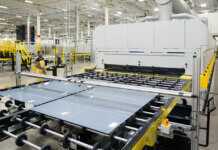First Solar Inc. is celebrating 25 GW DC of photovoltaic modules shipped since its founding two decades ago in 1999.
Headquartered in Tempe, Ariz., First Solar says its technological roots are in Perrysburg, Ohio, where the company achieved commercial production of its proprietary thin-film module technology in 2002. Since then, First Solar has celebrated other milestones, including the establishment of the industry’s first PV module recycling program in 2005. The company says it also became the first solar module manufacturer to break the $1 per watt barrier in 2009.
“Today, First Solar powers communities, infrastructure and decarbonization ambitions with the world’s cleanest PV solar technology – technology that forms the backbone of utility-scale solar fleets in some of the largest markets around the globe,” comments Mark Widmar, CEO of First Solar.
More recently, First Solar transitioned to its new large-format Series 6 module, which was designed and developed at the company’s research and development centers in California and Ohio. The module, leveraging First Solar’s proprietary thin-film technology, is produced in 3.5 hours using a fully integrated manufacturing process at factories in the U.S., Malaysia and Vietnam. The Series 6 module has a carbon footprint that is up to six times lower than that of crystalline silicon PV panels that are manufactured using conventional, energy-intensive production methods, the company claims.
First Solar says it is on track to become the largest solar module manufacturer in the Western Hemisphere when its second Series 6 factory in the U.S. becomes operational in early 2020. Once operational, the new facility in Perrysburg will take First Solar’s aggregate Series 6 manufacturing capacity to 5.4 GW per year.
Meanwhile, First Solar Energy Services, the company’s operations and maintenance segment, is also celebrating 10 years in business and 10 GW of assets under management.
The company also recently announced that it would be transitioning away from its internal engineering, procurement and construction (EPC) model in the U.S. and moving toward third-party EPC partners.




